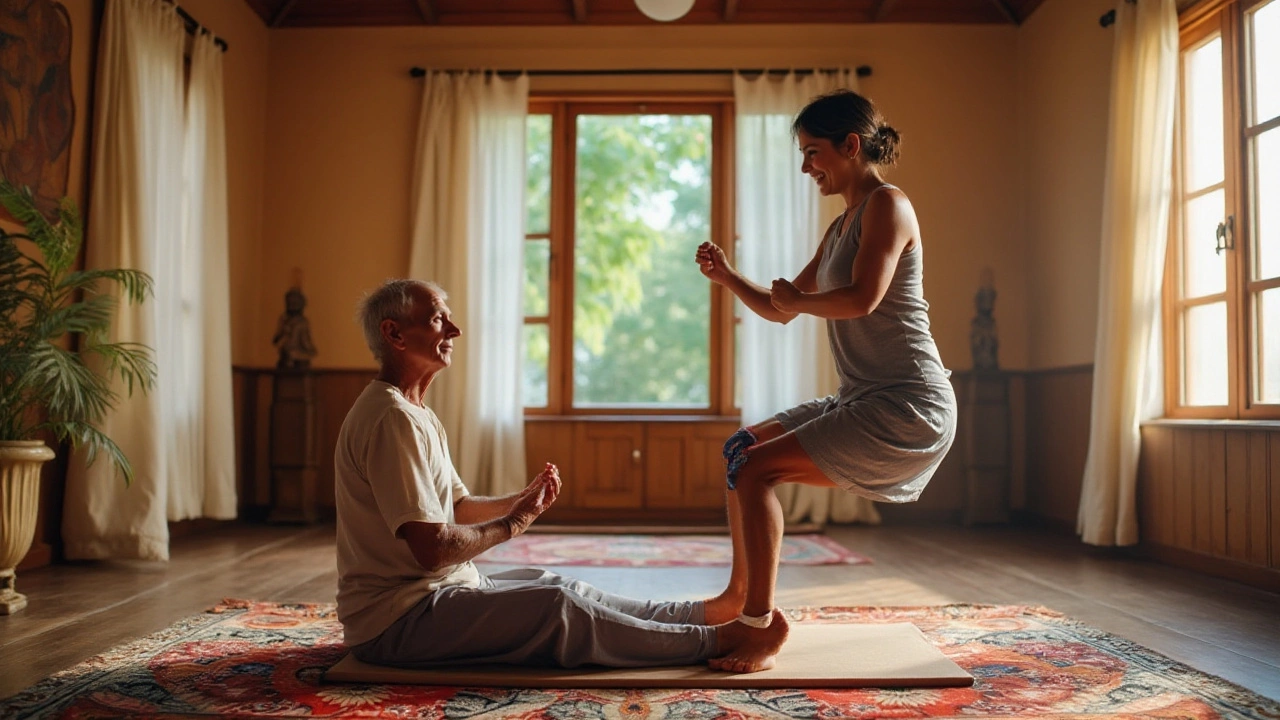Knee replacement surgery marks a significant milestone for many individuals seeking relief from persistent pain and a return to mobility. Yet, as with any medical intervention, the road to recovery is nuanced and demands careful consideration. A critical aspect of post-surgery care is the range of motion exercises, especially knee bending, which can be both beneficial and daunting.
Patients often ponder the question of how far they should go when trying to bend their surgical knee. Should they push through the discomfort, or is restraint the wiser path? The answer lies in understanding the human body's natural healing process and the specific guidance of healthcare professionals.
- Understanding Knee Replacement Surgery
- The Importance of Knee Flexibility
- Risks of Forcing the Knee
- Guidelines for Safe Knee Bending
- Expert Tips for Recovery
Understanding Knee Replacement Surgery
Knee replacement surgery, known medically as knee arthroplasty, is a procedure designed to replace the weight-bearing surfaces of the knee joint to relieve pain and disability. This procedure is predominantly performed for osteoarthritis, and also for other knee diseases such as rheumatoid arthritis and psoriatic arthritis. The surgery aims not just to ease pain, but to restore function and improve overall quality of life. Millions of knee replacement procedures are performed globally each year, with the vast majority yielding positive outcomes in terms of both relief and mobility.
A patient's journey to knee replacement often begins with chronic knee pain and severely limited mobility. This pain and reduced functionality come from the deterioration of cartilage in the joint, where bone eventually begins grinding on bone. Surgeons typically recommend knee replacements after other less invasive measures, like physical therapy or injections, have been exhausted. A startling fact is that by 2030, it's estimated that over 1.5 million people in the United States alone will undergo this surgery annually. Post-surgery rehab becomes a crucial step, ensuring that patients regain their knee's range of motion effectively.
The surgical procedure involves removing the damaged parts of the knee joint and capping the ends of the bones with metal and plastic components. This process allows the knee to carry weight and bend smoothly once healed. Depending on the patient's age and activity level, the artificial knee joint can last 15 to 20 years or even longer.
"Knee replacements are among the most successful interventions in modern medicine," notes Dr. Andrew Pearle, Chief of Sports Medicine at Hospital for Special Surgery. "But their success hinges heavily on rigorous post-operative care and rehabilitation."The mention of rehabilitation highlights the need to take on structured reconditioning exercises, including safe knee bending, to ensure the best possible recovery.
The Importance of Knee Flexibility
The journey towards regaining knee flexibility after surgery is akin to an epic tale of resilience and determination. Every bend, stretch, and movement contributes to something we often take for granted—our ability to move without inhibition. Knee flexibility is not just about the physical act of bending and straightening; it is a cornerstone of daily life activities that define our independence. Whether it’s climbing stairs, sitting down comfortably, or walking in the park, these actions hinge upon the articulated cooperation of our knee joints.
During the process of rehabilitation, knee flexibility becomes a focal point, guiding the trajectory of one's recovery. A major element behind successful rehabilitation lies in the approach taken to restore this flexibility without inadvertently causing harm. Forcing the knee to bend excessively can lead to setbacks, such as swelling or even tears in the healing tissues. Here, a balance is struck between gentle perseverance and mindful care. Patients are often advised to set realistic goals that align with their body’s capacity to heal, accommodating the natural ”ebbs and flows” of recovery.
Experts like Dr. Michael Adams, a renowned orthopaedic surgeon, emphasize the personalized aspect of rehabilitation in achieving optimal flexibility.
"Every patient’s recovery journey is unique,"Dr. Adams notes, highlighting the profoundly individual nature of healing. He advises against universal standards, advocating instead for personalized plans. Such tailored approaches account for various factors, including age, pre-surgery activity levels, and overall health.
One cannot overlook the role of physical therapy in the restoration of knee mobility. Physical therapists offer invaluable guidance, demonstrating exercises crafted specifically to support knee bending without exerting undue stress on the recently operated joint. Structured physical therapy programs frequently incorporate progressive resistance exercises that enhance joint strength, thereby facilitating a fuller range of motion over time. This development suggests something as simple and effective as performing seated knee bends or using a resistance band can substantially improve flexibility.
Data underscores the significance of a methodical approach to recovering knee flexibility. As presented in the "Journal of Arthritis and Rheumatology", studies show that individuals who engaged in consistent, supervised exercise regimens post-surgery saw a 70% higher improvement in knee flexibility compared to those who relied solely on self-guided routines. Such insights point towards the compounded benefit of involving professionals in one's post-surgical care.
Finally, patience and persistence are key allies on the road to rediscovering knee flexibility. Celebrated athletes and ordinary individuals alike attest to the power of a steadfast mindset. The journey may be peppered with challenges, yet each small victory—a deeper bend, less stiffness, or increased strength—is a stepping stone to full recovery.

Risks of Forcing the Knee
After undergoing knee replacement surgery, the temptation to push oneself towards a rapid recovery can often overshadow caution, particularly when it comes to physical therapy. A crucial element of this therapy involves improving knee flexibility, an area where patients might feel compelled to hasten progress by forcing their knee to bend. However, forcing the knee can pose significant risks and potentially hinder the healing process rather than help it. One notable concern is the excessive strain placed on the newly placed joint, which can lead to increased pain and inflammation. This strain may disrupt the delicate balance necessary for tissues to heal properly, causing setbacks in the recovery timeline.
Another critical aspect to consider is the undue pressure that forced bending can place on surgical incisions and surrounding soft tissues. Rushed recovery efforts often result in patients overlooking their body's pain signals, which act as a natural barrier against potential harm. Increased pressure can lead to complications such as swelling and delayed wound healing, making it essential for patients to maintain an approach that aligns with their body’s natural pace. Moreover, pushing the boundaries beyond what the body is prepared for can lead to serious complications such as blood clots or deep vein thrombosis. These conditions not only jeopardize the health of the leg but can also have life-threatening implications if not addressed promptly.
In situations where patients feel the urge to force their range of motion, it is worth remembering the age-old adage that patience is a virtue. Dr. William Macgregor, an orthopedic expert at a leading London clinic, once stated,
"While ambition in recovery is commendable, balance must be struck to allow for healing without forcing the body into a state it's not ready for."This wisdom emphasizes a mindful approach to rehabilitation, recognizing the coupling of rest and gradual effort as vital components of successful recovery. Furthermore, statistics underscore the importance of heeding medical advice; studies indicate that up to 10% of individuals who do not follow physical therapy guidance face complications that could require further medical intervention.
Recognizing Warning Signs
It is imperative for patients and their caregivers to be vigilant regarding symptoms and warning signs that may indicate overexertion during recovery. Such signs can include sharp or persistent pain during flexion, noticeable swelling around the joint, and visible redness or warmth, which could suggest infection. Having clear communication with physical therapists and healthcare providers is fundamental to distinguish normal post-operative sensations from those requiring attention. Informed attention to warning signs can not only prevent complications but also create a smoother path to integrating your post-surgery knee back into daily life activities.
Guidelines for Safe Knee Bending
Embarking on the journey of knee replacement recovery involves a keen awareness of how to safely reintroduce movement into the joint. Knee bending exercises serve as the cornerstone of a successful rehabilitation program, aiming to restore flexibility, reduce stiffness, and facilitate an optimal range of motion. It's critical to approach these exercises with patience and diligence, allowing the body to adapt without unnecessary strain.
Most healthcare professionals emphasize the importance of starting slow. Initially, passive range of motion exercises might be recommended, encouraging gentle movement without active effort from the muscles. As swelling subsides and healing progresses, active exercises like seated knee bends can be introduced. The goal is to gradually increase the knee's bending capacity without pain, aiming for around 90 degrees of flexion by the first week.
Step-by-Step Knee Bending Exercise
One effective approach to encourage safe knee bending is seated knee bends. Here's a straightforward method:
- Begin in a seated position with your feet flat on the floor.
- Slowly slide your foot back toward the chair, bending the knee as much as comfortable.
- Hold the position for a few seconds and then return to the starting point.
- Repeat the process, aiming for several repetitions multiple times a day.
Progress monitoring is key. Keeping a log of your bending range can serve as both a motivational tool and a valuable record for consultations with your physical therapist. It's essential not to force the knee when pain arises, as this could potentially derail progress by causing inflammation or even injury.
While each individual's recovery timeline can vary, experts often highlight the importance of consistency. Regular exercises, at intervals recommended by one's healthcare provider, keep the joint active and reduce the risk of long-term complications. A committed regime tailored to your specific condition can turn the intimidating process of rehabilitation into a manageable and rewarding endeavor.
"Patience and perseverance in following a strict rehab plan are crucial for a positive recovery," says Dr. Susan Miles, a leader in orthopedic rehabilitation. "It's about listening to your body and respecting its limits."
Monitoring Progress and Adjusting
Tracking progress over weeks provides insights into how well the knee responds to increased activity. It may be beneficial to utilize tools like goniometers to measure the exact angle of knee bends during exercise sessions. Adjustments to your routine should be made in consultation with physiotherapists or orthopedic specialists, ensuring that each phase of recovery aligns with medical best practices.
Igniting a sense of progress in joint recovery often requires creative solutions. Incorporating alternative exercises such as stationary cycling or water aerobics can aid in maintaining knee flexibility while reducing the risk of overexertion. By balancing routine exercises with complementary activities, patients can foster an environment conducive to regeneration and strength-building.
Ultimately, the journey of achieving full mobility after a knee replacement demands attention to detail and a willingness to adapt. By adhering to these guidelines and working seamlessly with healthcare teams, patients have the opportunity to reclaim their life and enjoy the benefits of newfound mobility.

Expert Tips for Recovery
Embarking on the recovery journey post-knee replacement is akin to navigating a new terrain. The healing process is unique to each individual, yet there are universal guidelines that can ease the path towards restored mobility and comfort. Experts emphasize the importance of remaining proactive while giving enough room for rest and healing. Balancing these two aspects can maximize recovery outcomes significantly. Moreover, the role of personalized physical therapy cannot be overstated. With each patient possessing distinct challenges and goals, customized therapy plans help cater to these specific needs, ultimately leading to better recovery.
Central to the success of knee recovery is maintaining an optimistic mindset throughout the process. Emotional readiness and mental resilience play crucial roles. Many healthcare professionals advocate for incorporating mental health support as an integral part of post-operative care, recognizing the stress that physical limitations can impose. Studies have shown that patients who adopt a positive attitude are more likely to experience a smoother rehabilitation journey. It's also prudent to engage with support groups, whether online or physical, that understand and empathize with the journey of joint recovery.
Practical Steps for Optimal Recovery
In the realm of recovery, following some practical and expert-advised steps helps in achieving optimal results. Firstly, adhere strictly to the exercise program prescribed by your physiotherapist. These exercises are thoughtfully designed to enhance mobility without causing undue stress on the healing joint. Additionally, it is essential to monitor pain levels closely. Pain is a natural signal from the body; hence, it's important to listen and adjust activity intensity accordingly. A study published by the American Academy of Orthopaedic Surgeons reveals that patients who paced their activity levels achieve more effective post-surgery rehab.
- Stay consistent with the prescribed exercises, and ensure you're doing them correctly.
- Keep regular appointments with your physiotherapist and communicate any concerns.
- Pay attention to nutrition; including proteins, calcium, and other essential minerals can aid healing.
- Hydration and adequate sleep are non-negotiable for recovery.
Implementing a holistic approach, combining physical care with mental wellness, is the cornerstone of efficient knee replacement recovery. As Dr. Laura Thompson, a renowned orthopedic surgeon, says,
"Patience and persistence are your best friends in recovery. Giving your body time and listening to what it communicates is key."
An often overlooked aspect is the environmental setup at home or wherever you are doing most of the recovery. Ensuring that your environment is safe and free from hazards that can lead to falls or strain on the new joint can make a huge difference. Small adjustments like anti-slip mats, assistive devices, and rearranging furniture to create open pathways can be highly beneficial. The natural inclination may be to rush back to daily routines, but careful pacing is crucial. Keep in mind that the journey to full recovery is a marathon, not a sprint.


 Health and Wellness
Health and Wellness




